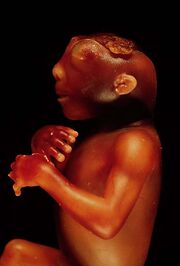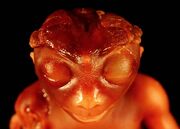| ICD-10 | Q000 | |
|---|---|---|
| ICD-9 | 740.0 | |
| OMIM | 206500 | |
| DiseasesDB | 705 | |
| MedlinePlus | [1] | |
| eMedicine | neuro/639 | |
| MeSH | C10.500.680.196 | |
Anencephaly is a fatal cephalic disorder that results from a neural tube defect that occurs when the cephalic (head) end of the neural tube fails to close, usually between the 23rd and 26th day of pregnancy. This causes the absence of a major portion of the brain, skull, and scalp. Infants with this disorder are born without a forebrain, the largest part of the brain consisting mainly of the cerebral hemispheres (which include the isocortex, which is responsible for higher level cognition, i.e., thinking). The remaining brain tissue is often exposed - not covered by bone or skin.
Babies are typically stillborn or die shortly after birth.[1] The longest an infant with anencephaly survived was to 28 months of age.[2]
Some pregnant people choose to abort in cases of anencephaly. This can help avoid health risks from cesarean sections or childbirth complications.[3]
Grief counseling, support groups, and a strong social support network may help parents cope with the loss.[4][5]
Presentation[]
"A baby born with anencephaly is usually blind, deaf, unaware of its surroundings and unable to feel pain. Although some individuals with anencephaly may be born with a main brain stem, the lack of a functioning cerebrum permanently rules out the possibility of ever gaining awareness of their surroundings. Reflex actions such as breathing and responses to sound or touch may occur." -National Institute of Neurological Disorders and Stroke [6]
Infants born with anencephaly are usually blind, deaf, unconscious, and unable to feel pain. Some have a rudimentary brainstem that allows them to automatically respond to touch.[4] However, they have no awareness and will never "wake up."
Diagnosis[]
Anencephaly can often be diagnosed before birth through an ultrasound examination. The maternal serum alpha-fetoprotein (AFP screening) and detailed fetal ultrasound can be useful for screening for neural tube defects such as spina bifida or anencephaly.
Anencephaly is sometimes confused with exencephaly or microcephaly. Also, sometimes a false prognosis stating that an anencephalic baby can live for years is given, but this cannot occur because the brain is open, meaning that infection sets in rapidly. The anencephalic brain is also usually very disorganised on a cellular level.
Prognosis[]

The side view of the above fetus.
There is no cure or standard treatment for anencephaly. It is always fatal. Infants that are not stillborn typically die in a few minutes, hours, or days after birth.
Clinics may offer hydration, nutrition, and comfort measures while they wait to "let nature take its course". Some parents request artificial ventilation to give them more time with their baby before death.[5] More intensive interventions, such as surgery or drug therapy, will not save the baby.
Some parents choose to donate their child's organs.[7]
Rate of occurrence[]
In the United States, approximately 1,000 to 2,000 babies are born with anencephaly each year. Female babies are more likely to be affected by the disorder.[8]
About 95% of women who learn that they will have an anencephalic baby choose to have an abortion.
Causes[]
The cause of anencephaly is unknown. Neural tube defects do not follow direct patterns of heredity. Studies show that a woman who has had one child with a neural tube defect such as anencephaly, has about a 3% risk to have another child with a neural tube defect. This risk can be reduced to about 1% if the woman takes high dose (4mg/day) of folic acid before and during pregnancy.
It is known that women taking certain medication for epilepsy and women with insulin dependent diabetes have a higher chance of having a child with a neural tube defect. Genetic counseling is usually offered to women at a higher risk of having a child with a neural tube defect to discuss available testing.
Low folic acid early in pregnancy may sometimes cause anencephaly.
Prevention[]
Preventing anencephaly isn't always possible. There are a few ways to reduce the risk.[4]
- Taking folic acid supplements when trying to conceive
- Discussing medications with a doctor when trying to conceive
- Managing health conditions like diabetes
However, even parents who follow best practices may have fetuses with anencephaly.
See also[]
Sources[]
External links[]
- Exencephaly – Anencephaly Sequence and its Sonographic Features
- Anencephaly
- Images of Anencephaly (Warning: Contains graphic medical images)
- Anencephaly, 3D
- Specimens - Anencephaly
- Case of Anencephaly in Nepal (Contains links not safe for work)
- Anencephaly info
- de:Anencephalie
| This page uses Creative Commons Licensed content from Wikipedia (view authors). |
- ↑ Facts about Anencephaly
- ↑ Dickman H, Fletke K, Redfern RE. Prolonged unassisted survival in an infant with anencephaly. BMJ Case Rep. 2016 Oct 31;2016:bcr2016215986. doi: 10.1136/bcr-2016-215986. PMID: 27799226; PMCID: PMC5093842.
- ↑ Ekmekci E, Gencdal S. What's Happening When the Pregnancies Are Not Terminated in Case of Anencephalic Fetuses? J Clin Med Res. 2019 May;11(5):332-336. doi: 10.14740/jocmr3777. Epub 2019 Apr 14. PMID: 31019627; PMCID: PMC6469884.
- ↑ 4.0 4.1 4.2 Anencephaly, Cleveland Clinic
- ↑ 5.0 5.1 Life-Prolonging Therapies in a Case of Anencephaly: A Mother’s Wish
- ↑ NINDS Anencephaly Information Page
- ↑ Newborn baby Teddy was UK's youngest ever organ donor
- ↑ Timson, J. The sex ratio in anencephaly. Genetica 41, 457–465 (1970). https://doi.org/10.1007/BF00958926
